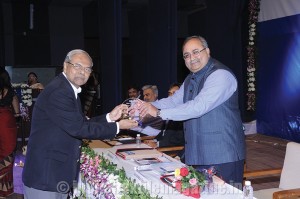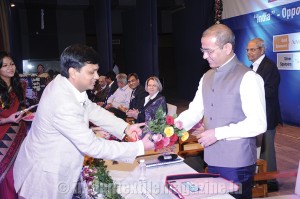India – Opportunities for Global Investment in Textile (Intexcon) conference recently held at Gandhinagar in Gujarat focused on the Indian textile industry as an investment destination by instilling confidence among potential Indian as well as foreign players to invest in this highly promising sector.

According to Dr. PR Roy, Partner at Diagonal Consulting India, which organised the conference along with Textile Excellence magazine, the Indian textile sector has in recent years been shunned by top corporate houses in India as well as overseas, and even those already present in the sector are avoiding expansion plans. “This conference, which is one of the first in India to have panel discussions among top experts on each and every segment of the textile value-chain, attempted to instill confidence among Indian and foreign investors by showcasing the positive aspects of the industry”.
Intexcon saw top experts sharing their perspectives of the entire textile value chain, covering fibre, yarn, shirting, bottom weights, textile technologies, home textiles, apparel brands, retail and the most important sustainable and eco-friendly means of production.
Inaugurating the three-day conference, Mr. Saurabhbhai Patel, Gujarat Minister of Finance, said the State’s growth-oriented textile policy has led to an accelerated flow of investments. The State Government is coming out with a separate policy for labour-intensive units. The incentives offered will be linked to the number of people that a unit employs, and even units set up in urban areas would receive incentives.
We have highlighted some of the interesting points from the conferences are highlighted. Mr. Rajesh Mandawewala from Welpsun India, said India has just six per cent share of the total global home textiles trade worth $45 billion. However, it has a 30-35 per cent share of all towels imported into the US and a huge 47 per cent in cotton bed sheets.
Mr. RC Udeshi from Reliance Industries, said that there is a need to create a scale of operations and that Indian entrepreneurs are happy that they have around 100 air-jet or water-jet looms as against 13,000 water-jet looms in operation in a single mill in China. “Currently, India produces only 4.5 million tons of polyester per annum, and in order to reach the target of $500 billion, we will need to increase polyester capacity to 20 million tons in the next 8-10 years.”
In her special address on Global Trends & Future of Spinning Technology, Ms. Edda Walraf, Marketing Head at Rieter Spun Yarn Systems, said two of the most important factors – raw materials and demand – played a major role in India. Of course, India has an edge over other countries as regards raw material, power and labour costs. Still automation is the only way to reduce costs and increase the overall efficiency.
Mr. Ajay Sardhana from Birla Cellulose: “At VSF also, we are fortunate to have a surplus capacity as the requirement in India is around 650 tons per day, whereas Birla Cellulose produces around 1,300 tons per day. However, the value chain needs to be developed and that India was able to make good quality yarn and fabrics, however there are shortcomings in fabric processing.”
Mr. Ajay Sardhana also added that India lacked in synthetic clothing brands, as most of the brands are cotton based, and if 3-4 good synthetic brands were to be promoted, a greater consumption of MMF-made textiles is unavoidable. “With the onset of e-commerce, developing a brand has become easier. So, e-commerce will create a very good opportunity for the synthetic value-chain and also for the decentralised sector, to create their own brands as done by Reliance Industries for its Vimal brand in earlier days.”
Mr. YC Gupta from Indorama India observed that there is a lot of scope for investment in downstream sectors that turn out products which use spandex as a blend with other fibres. India is consuming just 15,000 tons per annum, whereas in China it is about 360,000 tons. Hence, the huge potential left untapped.
Mr. Deepak Chiripal from Nandan Denim said per capita consumption of denim jeans is 0.4 in India which can easily go up to around 0.8 or one pair of jeans in the next 4-5 years and has the potential to almost double capacity. “Secondly, since denim jeans is also a fashion product, consumers will keep buying new denim products, a trend which will give a minimum of 15-20 per cent growth rate in the domestic market alone,” he noted.
Mr. Ganesh Subramanian from Myntra.com, said: “Since we are expecting internet penetration to double in the next three years, the e-commerce user base is expected to rise four-fold over the same period, which presents this business, an opportunity to grow by ten times in the next few years, purely through macro-economics.”
“The current overall Indian e-commerce market is roughly around $5-6 billion and we expect that to go to $70-100 billion by 2020, out of which roughly 35 per cent will be fashion related retail. We are talking about $30 billion of fashion business, which will be done online,” he told delegates.
